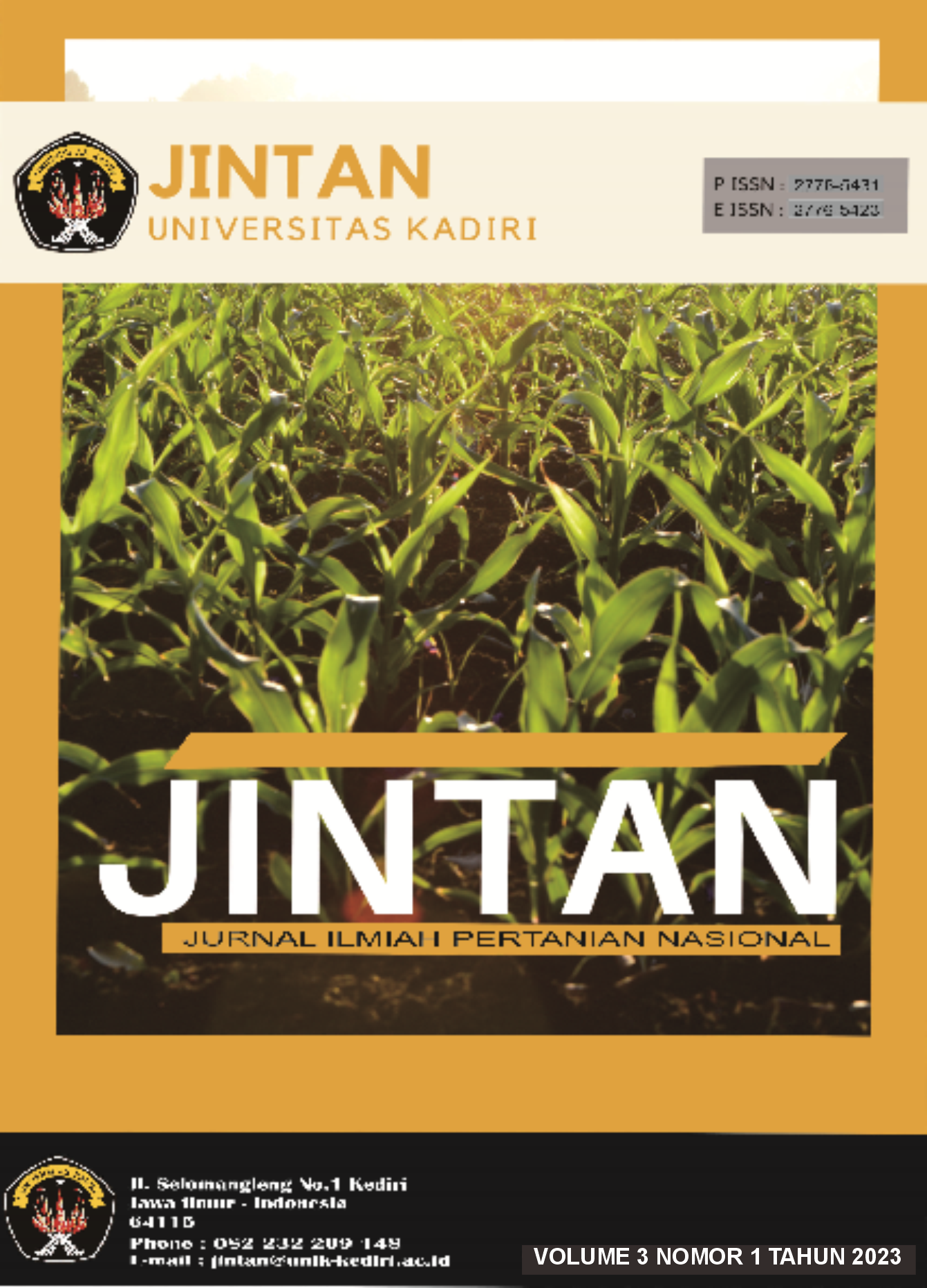Peranan Perawatan terhadap Pendapatan Usahatani Karet Kecamatan Gunung Purei Kabupaten Barito Utara
DOI:
https://doi.org/10.30737/jintan.v3i1.3976Keywords:
Rubber Maintenance, Income, Rubber Farming.Abstract
The rubber plant (Hevea brasiliensis) is grown in large plantations. Rubber is a strategic plantation commodity because it has high economic value and is a non-oil and gas export material. In general, rubber farmers use local seeds so that the quality of rubber is low, and there is a lack of care for rubber plants, especially fertilizing, cleaning, pruning, and irregular tapping. Improper post-harvest handling also results in decreased rubber production and quality. This study aimed to determine the effect of plant maintenance on rubber farming income in Gunung Purei District. The research method was descriptive quantitative. The sampling method used simple random sampling through questionnaires to seventy respondents. The results showed that the types of rubber maintenance carried out were pruning, fertilizing, cleaning, and tapping. The income of rubber farmers with treatment (IDR 12,860,000) was higher than that without treatment (IDR 10,148,000). The results of the statistical test showed that the variance was homogeneous. Meanwhile, there was a significant difference between income in the maintenance treatment and without treatment. Therefore, it is necessary to treat rubber plantations to increase productivity.
Â
Karet menjadi komoditas perkebunan strategis karena memiliki nilai ekonomi tinggi serta menjadi salah satu bahan ekspor non migas yang penting. Para petani karet dominan menggunakan bibit lokal serta kurangnya perawatan tanaman karet sehingga mempengaruhi produktivitasnya yang nantinya akan berdampak terhadap pendapatan. tujuan penelitian ini untuk mengetahui jenis perawatan yang dilakukan petani karet di kecamatan Gunung Purei serta untuk mengetahui pengaruh jenis perawatan terhadap pendapatan petani karet. Metode pengambilan sampel ini menggunakan simple random sampling melalui kuesioner ke petani karet dengan jumlah petani sebanyak 70 orang. Hasil penelitian menunjukkan bahwa jenis perawatan karet yang dilakukan adalah pemangkasan, pemupukan, pembersihan dan penyadapan. Pendapatan petani karet dengan perlakuan perawatan (Rp12.860.000) lebih besar dibanding dengan tanpa perawatan (Rp10.148.000). Hasil pengujian statistic dengan uji F menunjukkan bahwa varian homogen. Sedangkan Hasil Uji T menunjukkan adanya perbedaan secara siginifikan antara pendapatan pada perlakuan perawatan dengan tanpa perawatan. Maka itu perlu dilakukan perawatan terhadap tanamna karet agar meningkatkan produktivitas
References
Amirullah. (2019). Jurnal Populasi Dan Sampel. Wood Science and Technology, 16(4), 293–303.
Budiyanto, Siti, Erlina, S. (2016). Kontribusi Tanaman Karet (Hevea
rasiliensis) Dan Faktor Faktor Yang Mempengaruhi Pendapatan Rumah Tangga. Jurnal, 1–10.
Endang. (2013). Jurnal Kontribusi pendapatan usahatani karet (.10(1), 28–34.
Iswahyudi, H., Isnaini, N., & Hakiki, R. (2018). Kajian Pengelolaan Perkebunan Karet Rakyat di Kabupaten Kapuas Kalimantan Selatan. Jurnal Agrisains, 4(2), 30–37.
Sodikin. (2014). Analisis Pendapatan Usahatani Petani Karet Dan Konsumsi Pangan Rumah Tangganya Di Kecamatan Rimbo Bujang Kabupaten Tebo. UIN Maulana Malik Ibrahim, 39(1), 1–15.
Soeprajogo, M. P., & Ratnaningsih, N. (2020). Perbandingan Dua Rata Rata Uji T. Pusat Mata Nasional Rumah Sakit Mata Cicendo.
Sugiyono. (2012). Memahami Penelitian Kualitatif. ALFABETA.
Supardi. (2013). Aplikasi Statistika dalam Penelitian Konsep Statistika yang Lebih Komprehensif. Change Publication.
Wiyanto, W., & Kusnadi, N. (2013). Faktor-Faktor Yang Mempengaruhi Kualitas Karet Perkebunan Rakyat (Kasus Perkebunan Rakyat di Kecamatan Tulang Bawang Tengah Kabupaten Tulang Bawang, Lampung). Jurnal Agribisnis Indonesia, 1(1), 39. https://doi.org/10.29244/jai.2013.1.1.39-58
Zaini, A., Juraemi, Rusdiansyah, & Saleh, M. (2017). Pengembangan Karet (Studi Kasus di Kutai Timur) (Kiswanto (ed.)). Mulawarman University PRESS.
Downloads
Published
Issue
Section
License
Authors who publish in this journal agree to the following terms:
- Authors retain copyright and grant the journal right of first publication with the work simultaneously licensed under a Creative Commons Attribution License (https://creativecommons.org/licenses/by-nc-nd/4.0/) that allows others to share the work with an acknowledgment of the work's authorship and initial publication in this journal. Permitted third party reuse is defined by the Creative Commons Attribution-NonCommercial-NoDerivs (CC BY-NC-ND). This permission allows users to copy and distribute the Article, provided this is not done for commercial purposes and further does not permit distribution of the Article if it is changed or edited in any way, and provided the user gives appropriate credit (with a link to the formal publication through the relevant DOI), provides a link to the license, and that the licensor is not represented as endorsing the use made of the work.
- Authors are able to enter into separate, additional contractual arrangements for the non-exclusive distribution of the journal's published version of the work (e.g., post it to an institutional repository or publish it in a book), with an acknowledgment of its initial publication in this journal.
- Authors are permitted and encouraged to post their work online (e.g., in institutional repositories or on their website) prior to and during the submission process, as it can lead to productive exchanges, as well as earlier and greater citation of published work.
- For open-access publishing, authors have the right to share their articles in the same ways permitted to third parties under the relevant user license, as well as certain scholarly usage rights.
Deprecated: json_decode(): Passing null to parameter #1 ($json) of type string is deprecated in /home/ojs.unik-kediri.ac.id/public_html/plugins/generic/citations/CitationsPlugin.php on line 68




